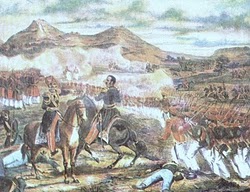Battle of Famaillá
This article includes a improve this article by introducing more precise citations. (September 2014) ) |
| Battle of Famaillá | |||||||
|---|---|---|---|---|---|---|---|
| Part of the Argentine Civil War | |||||||
 Detail of a lithography of the battle | |||||||
| |||||||
| Belligerents | |||||||
|
Federal army | Unitarian army | ||||||
| Commanders and leaders | |||||||
| Manuel Oribe | Juan Lavalle | ||||||
| Strength | |||||||
| 2,200 | 2,000 | ||||||
The Battle of Famaillá (
Prelude to the battle
After the failure of Lavalle's army to occupy
While Lamadrid formed a new army in Tucumán Province, Lavalle spent several months in a campaign in
Lavalle was finally forced to retreat towards
The battle
After trying to avoid the enemy main force in order to buy time to reinforce his army, Lavalle waited for the Federals on the north bank of the Famaillá river, about 40 km (25 mi) south of the provincial capital. Lavalle's forces comprised about 2,000 men, and the federal army about 2,200, after general Eugenio Garzón's, moved out to occupy the city of Tucumán.
The battle started at mid-morning. The Unitarian army included Marco Avellaneda, Juan Esteban Pedernera, Manuel Hornos and other notables. Among the Federals there were Juan Felipe Ibarra, Celedonio Gutiérrez, Hilario Lagos and Mariano Maza. At first it seemed it would last without definition for a long time, but early on it was clear that the veterans of the Federal army easily outclassed Lavalle's soldiers. The victory was in the hands of Oribe, and Lavalle and his men were forced to run away.
Consequences
Avellaneda escaped to the north, but betrayed by his security chief, he would be executed at Metán by orders of Oribe and Maza. Lavalle escaped to San Salvador de Jujuy, where he was killed on a chance encounter with a Federal party. His remains were carried to Potosí, Bolivia, by Pedernera. The latter would have more luck, as he eventually reached the post of vicepresident of the nation, although he was forced to preside on the dissolution of his own government in 1861.
On the Federal side, Gutiérrez would become governor of Tucumán for 10 years; Lagos would become the chief of the Federal party of Buenos Aires after the fall of Rosas, and Oribe would return to his country, Uruguay, to govern for another nine years.
The Battle of Famaillá signaled the end of the Coalition of the North. It was also Lavalle's last battle, and the next to last in the civil war. Only ten days later, Lamadrid was defeated at the Battle of Rodeo del Medio, and the country would be controlled by the Federalist Party, almost without opposition for another ten years.
Bibliography
- "Partes de batalla de las guerras civiles". Academia Nacional de la Historia. 1977.
- Aráoz de Lamadrid, Gregorio (1895). Memorias. Buenos Aires.
{{cite book}}: CS1 maint: location missing publisher (link) - Best, Félix (1980). Historia de las Guerras Argentinas. Buenos Aires: Peuser.
- Beverina, Juan (1923). Las campañas de los ejércitos libertadores 1838-1852. Buenos Aires.
{{cite book}}: CS1 maint: location missing publisher (link) - Páez de la Torre, Carlos (h) (1987). Historia de Tucumán. Buenos Aires: Plus Ultra. ISBN 950-21-0907-4.
- Ruiz Moreno, Isidoro J. (2006). Campañas militares argentinas. Buenos Aires: Emecé. ISBN 950-04-2794-X.
- Saldías, Adolfo (1987). Historia de la Confederación Argentina. Buenos Aires: Hyspamérica.
- Sosa de Newton, Lily (1973). Lavalle. Buenos Aires: Plus Ultra.
- ISBN 950-614-685-3.
- Baldrich, Fernando A. (1977). "Mariano Maza, el implacable represor". Revista Todo es Historia (79).
- Poenitz, Erich (1977). "Los correntinos de Lavalle". Revista Todo es Historia (119).
